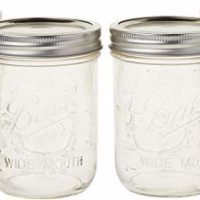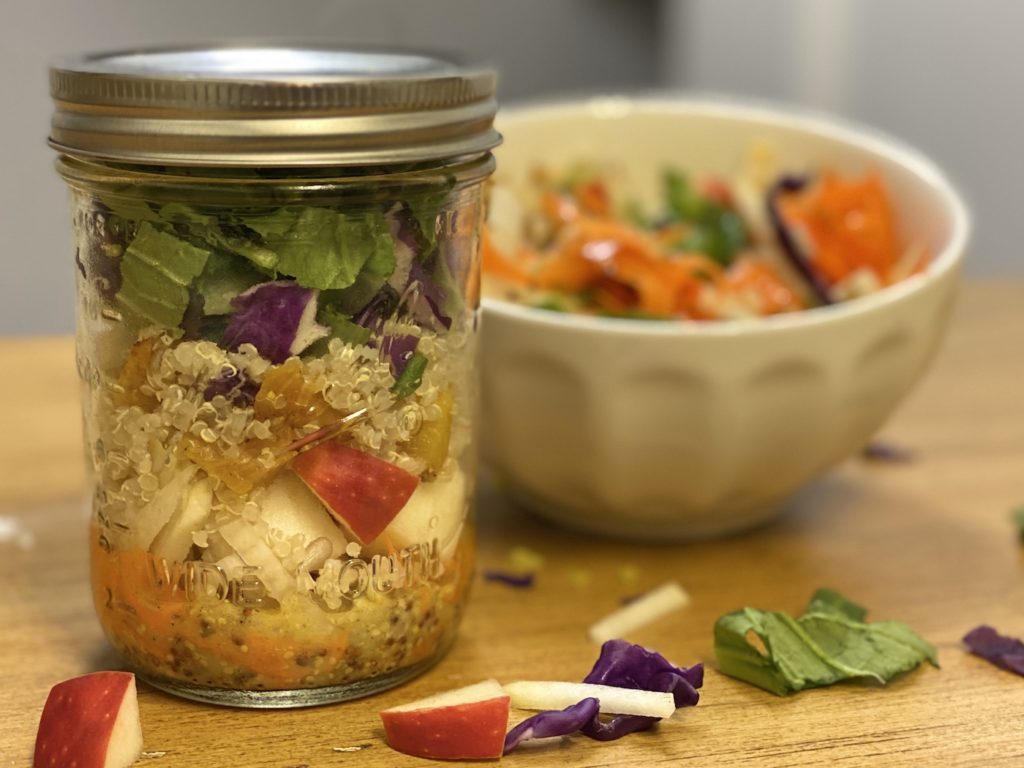
This post contains affiliate links. As an Amazon Associate I earn from qualifying purchases. This means if you make a purchase from a link on my site, I may earn a commission at no extra cost to you. I will never recommend a product or service that I do not personally use or like.
I have been hanging on to this topic for a while now. I kept thinking to myself, “you have to wait until spring to talk about salads!” But honestly at this point in the winter, the cold dark days are starting to wear on me. So when I received a gorgeous winter salad mix in my CSA farm basket this week, I knew it was time for salad in a jar!
I hardly invented the concept of salad in a jar but I have made dozens of versions. A few years ago, I was part of this great group, started by my friend Mandria, which we liked to call “Salad Club”. Basically, folks signed up to bring an ingredient from the week’s recipe and we all built our salads in jars together! It was genius! Community meal prep. And we all walked away with a week’s worth of lunches and meal starters.
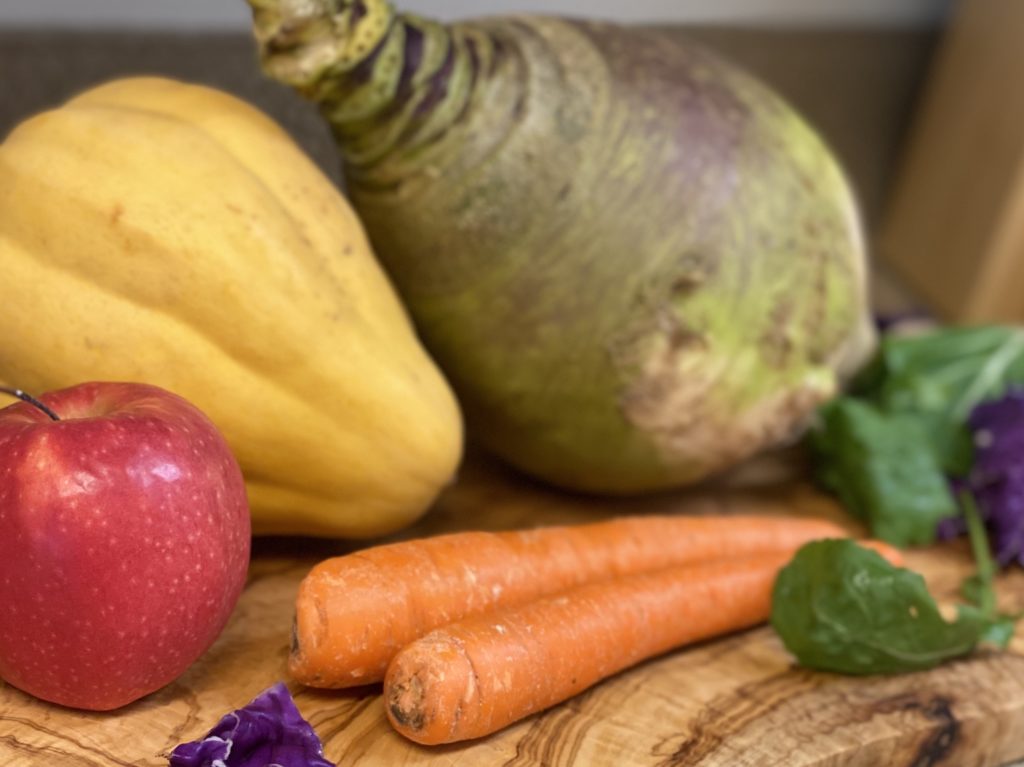
This layering method is based on the one from the Kitchn.com. By prepping a number of these bad boys early in the week, you’ve got yourself an easy, healthy, grab-and-go lunch. And because you can eat them right out of the jar, you can literally enjoy them anywhere: your car, the train, at work, at home, the zoo, the park, the beach…. trust me I’ve done it!
What is a Salad in a Jar
If you read my post about soup in a jar, this idea will be quite familiar. It’s fundamentally the same concept. Salad in a jar is a complete salad, dressing and all, assembled in a jar kind of upside down. Dressing goes in the bottom followed by harder veggies, then softer ingredients. Fresh greens go in at the top to prevent them from getting gross and soggy. And depending on what ingredients you put in, they can stay fresh all week!
The Salad Jar
A pint sized wide mouth Mason jar is perfect for this. But you could use a different container if you like. A pint, or two cups, is a good lunch sized portion for most folks. If you want, you can double the ingredients and use a quart sized jar for a more “family sized” salad.
The shape of the jar also serves to keep the ingredients layered. This maintains freshness and keeps things from getting soggy. You’ll also want the jar full to minimize the air inside.
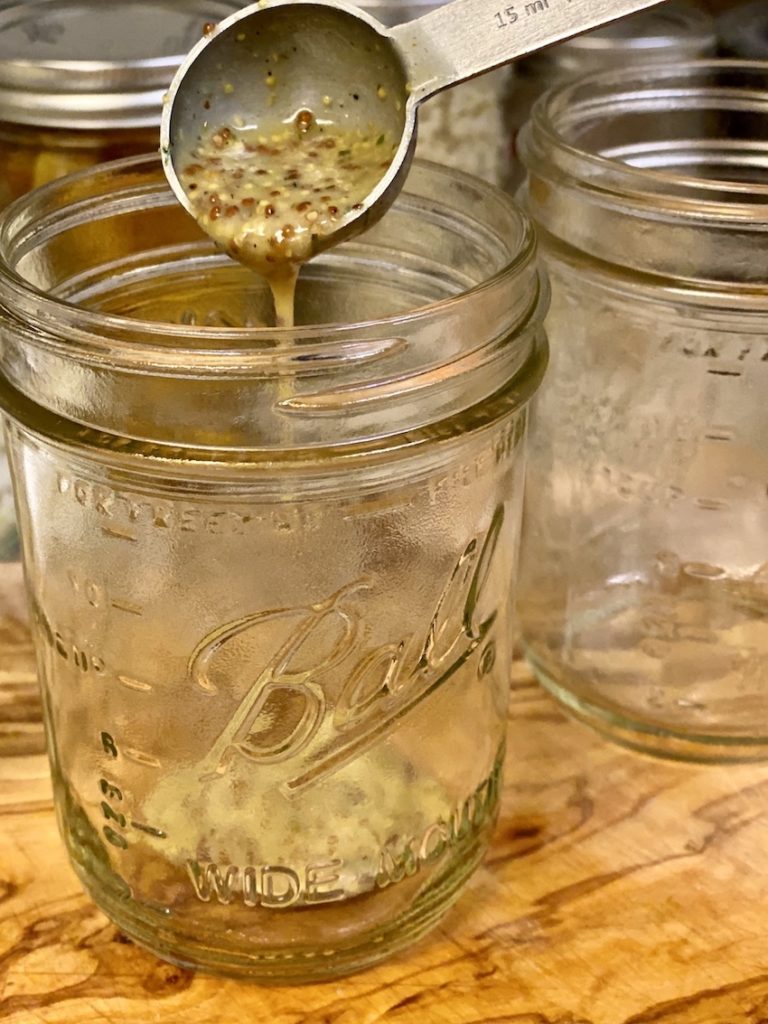
The Dressing
Dressing is the first thing to go in the jar. I find 2 tablespoons is the right amount for me, but of course adjust to your preference. You can save a bundle here by making your own vinaigrette. It’s really quite simple if you’ve never done it! There are tons of ideas online but the basic ratio most folks follow is 3 parts oil to 1 part vinegar/acid. For a little something different, hummus also makes an excellent salad dressing!
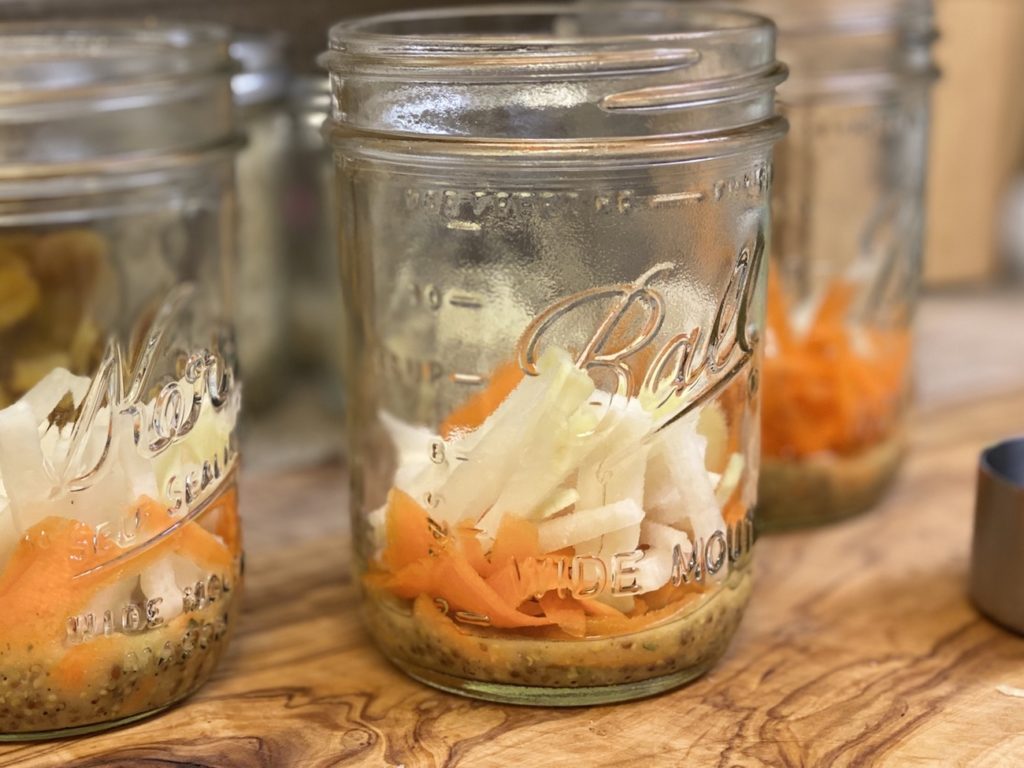
Veggies: Hard to Soft
Now for the veggies. I like to aim for about ¾ -1 cup total of these ingredients per pint sized jar. A good rule of thumb is about 1/4 cup per ingredient. And the first thing to go in should be “hard” veggies. These are your vegetables that won’t be bothered by sitting in the dressing for a few days.
Hard Vegetables
Diced or shredded carrots, bell peppers, broccoli slaw, radishes, cucumbers etc. Apples, while obviously not a veggie, also work particularly well in this category and add an unexpected sweet/tart crunch. I like to chop and toss them with a sprinkle of lemon juice to prevent browning.
Some frozen vegetables can work, too. Frozen corn and peas are my favorite. If you’re prepping your salad in jars ahead of time, there is no need to thaw as they will have time to defrost and be ready to eat.
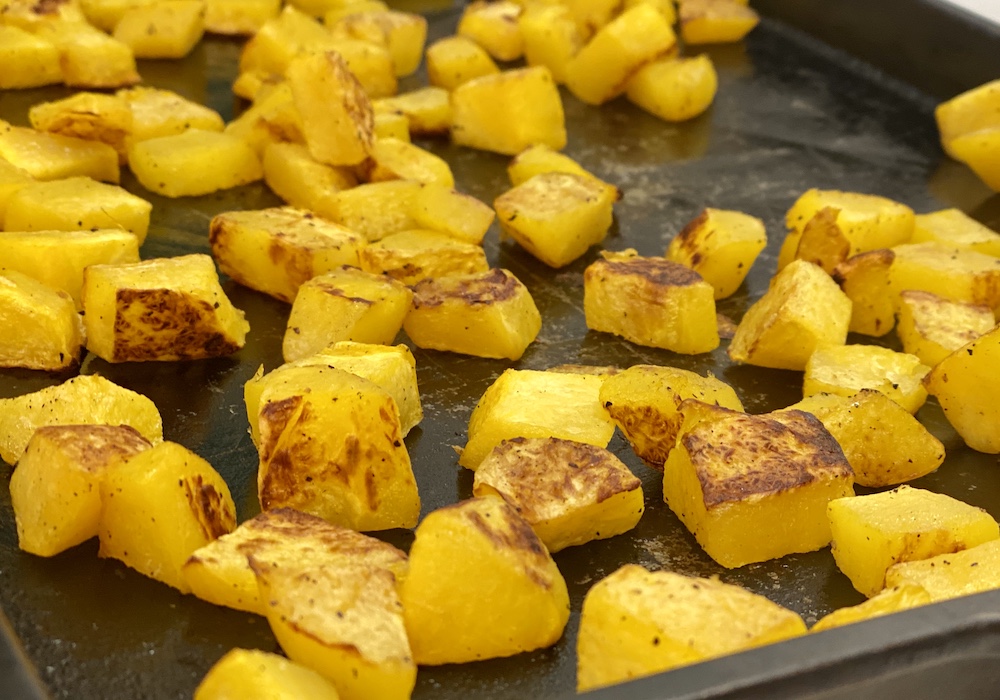
“Soft” Veggies and Beans
Roasted veggies – This is an awesome use for leftover cooked produce. As you may know, I’m a huge fan of anything roasted. This is an awesome way to use up that last bit of roasted squash, sweet potatoes, beets, onions, etc!
Canned/cooked beans or cooked lentils– I love beans in salad and this is a great way to add extra protein and fiber to your lunch. Black beans, white beans, chickpeas, whatever kind you like will work.
Softer fruits– Fruits in salad! Add chopped mango or pears, mandarin slices, whole berries. One caution, I find that these soft fruits don’t keep as long. So plan to eat these fruity salads within a couple days of prepping them.
Dried fruit– Here’s another easy way to elevate your salad. Dried cranberries, chopped dates or apricots, raisins, and so on can add flavor and texture to the mix.
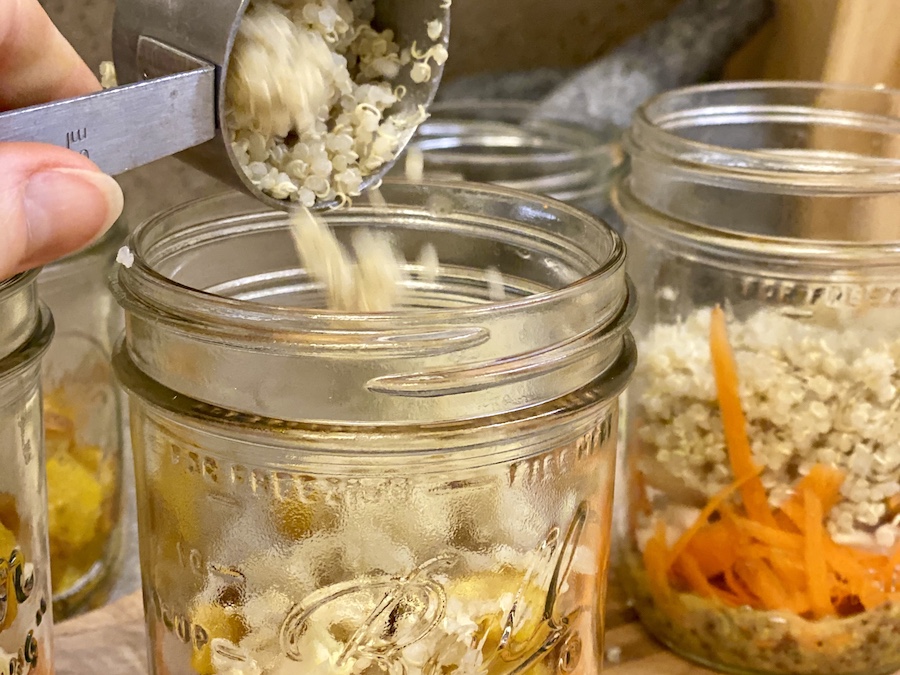
Grains and Noodles
On top of all that, you can add a ¼ cup or so of cooked and cooled grains. (Don’t add them still hot!) These can really bulk up salads and make them more filling. Quinoa is my favorite, but brown rice, barley, even small noodles are good ideas.
Pack in the Greens
Bring on the greens! You’ll want to aim for about 3/4 to 1 cup of salad greens: lettuce, spinach, kale, cabbage, any mix you like! Here I used a peppery winter greens mix from my CSA farm share which included arugula, mustard greens, red cabbage, and radicchio! Don’t be afraid to really pack them in there tightly, but gently. We don’t want to crush the leaves, but a snug fit will reduce air flow and help maintain the freshness of the whole salad in a jar.
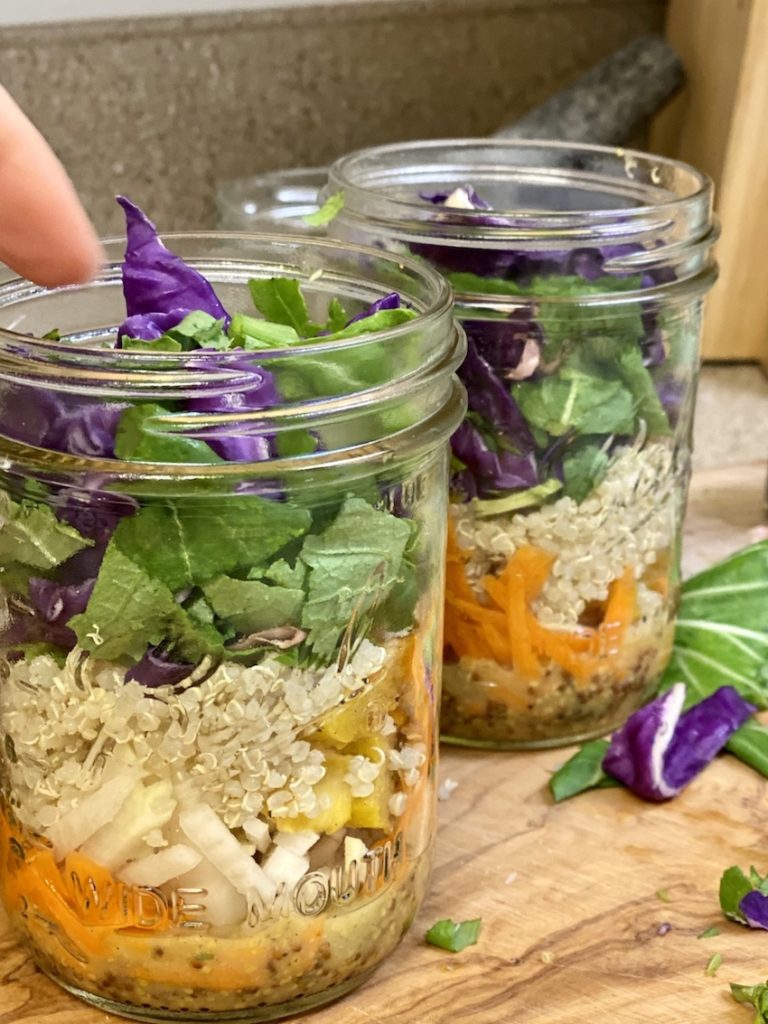
Seeds, Nuts, and Delicate Herbs on Top
Now for the little extras that will really bring this salad to life! Add a tablespoon or so of chopped cilantro, basil, parsley, and diced scallions or leeks. Slivered almonds, crushed peanuts, sunflower seeds, and pumpkin seeds add a bit of crunch and enhance the nutritional profile of your jar salad. This kind of stuff should hang out on top of the jar where it is protected from getting crushed or soggy. Shoot for 1-3 tablespoons of these flavor extras.
The Salad in a Jar Unrecipe
Now, remember this is only a guide, a basic blueprint. But here’s roughly what it should look like, the unrecipe if you will.
- 2 T dressing
- 3/4 – 1 cup chopped, diced, or shredded veggies, hard fruit, or beans
- 1/4 cup cooked and cooled grain or pasta
- 1/2 – 1 cup fresh salad greens
- 1 T diced flavorful fresh herbs or onions
- 1 T nuts or seeds
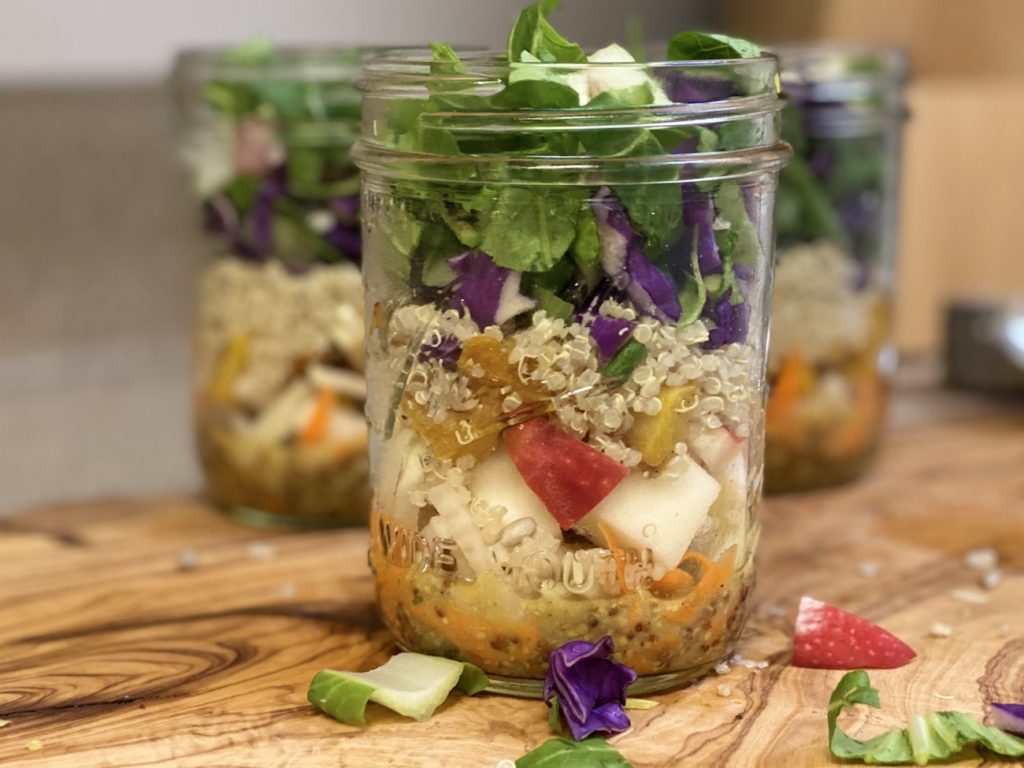
What About the Protein?
You may have noticed I left the protein out of our salad in a jar. For maximum fridge life, pack your cooked chicken, diced hard boiled eggs, cheese, etc. in a sidecar. Just add it in when you are ready to eat.
The same goes for tomatoes and avocado. While you can add whole (not diced!) cherry/grape sized tomatoes directly to the jar, it’s not ideal to store them in the fridge. So I like to leave these out as well and add them when I’m ready to chow down.
Without these ingredients, a vegetable/grain-only jar will be fresh for 5ish days in the fridge!
Let’s Eat Salad in (or Out of) a Jar!
Finally, to enjoy, just dump your jar salad into a bowl and give it a little stir! If you want to eat it straight from the jar, which I often do, remove (or eat) a bit of the lettuce and give it a good shake. These little guys are a lifesaver when you only have a few minutes to get out the door and you need to grab a fast lunch on the go!
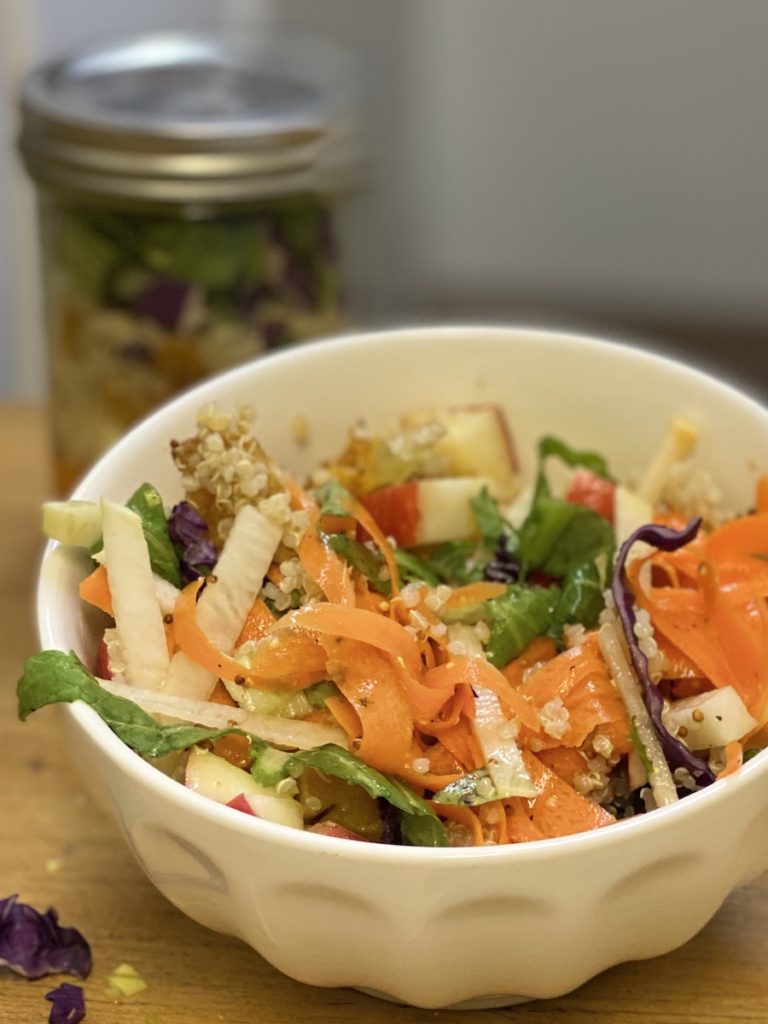
Not Just for Lunchtime: Meal Starters
Ok we get it, this is a brilliant lunchtime option. But she’s more than just a one-hit wonder! I plan to share more versatile recipe ideas in the future, but here are a few outside the box inspirations to get you started.
Stir fry: With ingredients like cabbage, carrots, peppers, peas, and green onions, get a jump on your dinner prep by dumping the contents of your jar into a skillet for an easy stir fry starter.
Breakfast (or breakfast for dinner): Create amazing omelettes, scrambles, or frittatas by sauteing your pre-prepped veggie mix and adding eggs.
Dinner side: Prep your salad in a quart size mason jar to make a great side salad for family dinner.
Just add protein: Adding grilled chicken, strips of steak, or a filet of fish creates a complete and satisfying dinner salad any night of the week.
I have literally made hundreds of salads in jars and still I find new combinations to love, inspired by the flavors of the season. Here is delicious, printable recipe idea for Turnip and Roasted Squash Salad with Lemon Dijon Dressing, in a jar of course!
Lemme know what you think! I would love to hear what you come up with. Please share in the comments below.
Turnip and Roasted Squash Salad (in a Jar) with Lemon Dijon Dressing
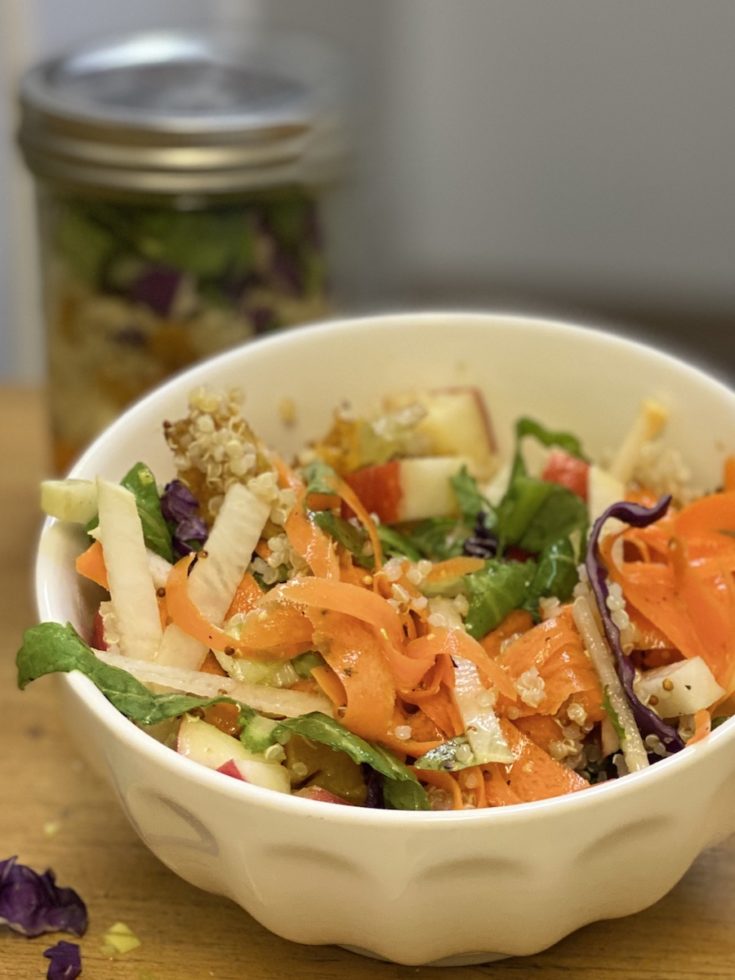
It’s convenient, healthful, and easy on the wallet; salad in a jar is one of my favorite lunchtime hacks. This salad was inspired by Gilfeather turnip, and celebrates the flavors or the season!
Ingredients
For the Lemon Dijon dressing
- 5 T lemon juice
- 1/2 cup extra virgin olive oil
- 1 T dijon or spicy mustard
- Salt and pepper to taste
For the Salad
- 1/4 cup shredded carrots
- 1/4 cup diced Gilfeather turnip, or other turnip or radish
- 1/4 cup tart apple, diced and sprinkled with lemon juice
- 1/4 cup diced, roasted, and cooled winter squash*
- 1/4 cup quinoa, cooked and cooled
- about 3/4 cup chopped winter greens mix (mustard greens, cabbage, arugula, radicchio, etc)
- 1 T chopped leeks or green onion
- 1 T sunflower seeds
Instructions
For the Lemon Dijon Dressing:
- Whisk lemon juice, olive oil, and mustard together in a small bowl or jar. Season with salt and pepper to taste.
To assemble the Salad in a Jar:
- In a wide mouth pint sized Mason jar (or similar container with a lid) layer ingredients in the following order: 2 Tablespoons dressing, carrots, turnip, apples, roasted squash, quinoa.
- Next, add as many salad greens to the jar as will fit, packing them in tightly, but without crushing.
- Sprinkle diced leek and sunflower seeds on top.
- Secure lid and store in the fridge for later use (up to 5 days in advance).
Notes
When ready to eat, dump the entire contents of the jar into a bowl. If you want to eat the salad in the jar, shake it up to mix ingredients. (You may need to remove a little lettuce to create enough space for the ingredients to combine.)
* To roast squash: peel and dice winter squash into bite sized pieces. Toss in olive oil or other cooking oil of your choice and sprinkle with coarse salt. Spread squash onto a sheet pan. Roast at 425 F for about 25 minutes, checking and stirring occasionally, until a light char has formed on the pieces.
Recommended Products
This post contains affiliate links. As an Amazon Associate I earn from qualifying purchases. This means if you make a purchase from a link on my site, I may earn a commission at no extra cost to you. I will never recommend a product or service that I do not personally use or like.
